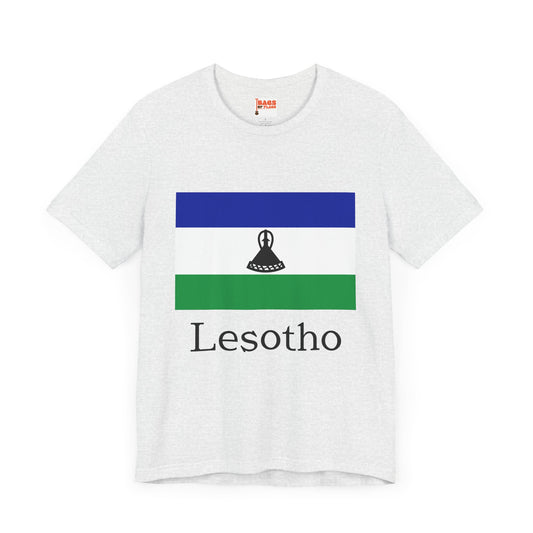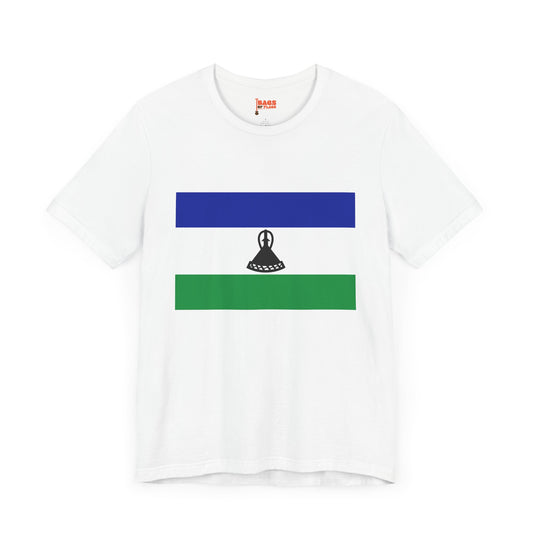-
Lesotho Hoodies
Regular price $34.40 USDRegular priceUnit price / per -
Lesotho T-shirts
Regular price $22.79 USDRegular priceUnit price / per -
Lesotho Flag Hoodies
Regular price $34.40 USDRegular priceUnit price / per -
Lesotho Inspired Hoodie
Regular price $34.40 USDRegular priceUnit price / per -
Lesotho Inspired T-shirt
Regular price $22.79 USDRegular priceUnit price / per -
Lesotho Flag on T-shirt
Regular price $22.79 USDRegular priceUnit price / per
Collection: Lesotho
The Lesotho flag, also known as the flag of Lesotho, symbolizes pride and identity for the people of this landlocked country in southern Africa. This comprehensive study will delve into the flag's design, historical context, symbolism, current relevance, and additional facts.
Overview of the Lesotho Flag

Lesotho's flag showcases a striking horizontal tricolor of blue, white, and green stripes. At the heart of the flag lies a distinctive black mokorotlo, a traditional Basotho hat, positioned at the center against the white band. The blue stripe at the top symbolizes the sky and rain, vital elements for a nation that relies heavily on agriculture and natural resources. Beneath this, the white stripe stands as a beacon of peace, urging harmony among the people of Lesotho and their neighbors. The green stripe anchors the flag, representing the fertile lands of Lesotho and the prosperity it brings to its inhabitants. This carefully chosen palette of colors and the central symbol work in concert to reflect the aspirations, culture, and environmental heritage of the Basotho people. Each element of the flag's design is imbued with meaning, making it a powerful emblem of national identity and pride.
Historical Context of the Lesotho Flag
As it stands today, the Lesotho flag was officially adopted on October 4, 2006, a landmark moment that marked a new chapter in the nation's identity and pride. This adoption was not the first in Lesotho's post-independence era; the country had used different national flags since gaining sovereignty from Britain in 1966. Each change in the flag's design reflected a shift in the nation's political landscape and aspirations and a desire to more accurately embody the spirit and values of the Basotho people.
The original flag, introduced upon independence, carried different symbols and colors, which were replaced in subsequent years to address changing national sentiments and political considerations. The 2006 redesign, which resulted in the current flag, was prompted by a desire to move away from past political associations and foster a sense of unity and forward-looking optimism among the populace. It was a step towards reconciling the diverse elements within Lesotho and promoting a collective national identity.
This latest change was notably significant, as it coincided with Lesotho's 40th anniversary of independence, symbolizing a rebirth or new dawn for the country. Introducing the mokorotlo, a deeply symbolic and culturally significant emblem at the heart of the flag's design, reinforced the nation's dedication to preserving its cultural heritage while embracing the future. The adoption process and the choices made in the flag's design reflected a broader conversation about national identity, heritage, and the aspirations of the Lesotho people.
Symbolism Embodied in the Flag

At its core, the Lesotho flag carries a profound depth of meaning through its simple yet evocative design. The blue stripe soaring above symbolizes the sky and the rain, both crucial elements for a nation whose lifeblood is agriculture and the natural resources bestowed upon its land. It's a reminder of the dependence on and respect for the natural environment that sustains the country's people and their way of life. Below, the white stripe acts as a bridge, representing peace and harmony within Lesotho and its relations with neighboring countries. It underscores the nation's commitment to living in tranquility and fostering a society where unity prevails over division.
The green stripe grounds the flag, embodying the fertility of Lesotho's lands—a nod to the prosperity and growth of nurturing the earth. At the center, the black mokorotlo, a traditional Basotho hat, is more than a cultural artifact; it's a symbol of unity and the national identity that binds the people of Lesotho together. This emblem highlights the importance of preserving and celebrating Basotho culture amidst the waves of change. Each color and symbol intertwined within the flag's fabric serves as a daily reminder to the Basotho people of their shared values, hopes, and connection to the land and each other.
Current Relevance of the Lesotho Flag
Today, the Lesotho flag is integral to the nation's fabric, flying high at government buildings, educational institutions, and international gatherings to represent the country. It serves as a beacon of national pride, especially during significant moments such as Independence Day and King’s Birthday celebrations, where it symbolizes unity and the collective spirit of the Basotho people. In military ceremonies, the flag is honored as a tribute to the bravery and dedication of Lesotho's armed forces.
Although discussions around the flag's design and its symbolism occasionally surface, these dialogues underscore the flag's role as a living symbol of the nation's identity, reflecting its people's evolving aspirations and values. As such, the flag fosters a sense of belonging and pride among Lesotho's citizens, serving not just as a national emblem, but as a constant reminder of the country's heritage and the common goals that guide its future.
Additional Facts About the Lesotho Flag
Unique protocols and traditions surround the handling and display of the Lesotho flag, emphasizing its importance as a national symbol. For instance, there is a designated protocol for raising and lowering the flag precisely at the break of dawn and the close of dusk, reflecting the nation's reverence for its emblem. A key rule that accompanies the flag's display is ensuring it never makes contact with the ground, a practice common with national flags to signify respect and honor. Additionally, the flag must always be handled with the utmost care and dignity, which is a testament to its significance in representing the country's identity and values.
An intriguing aspect of the Lesotho flag is its inclusion of a hat, the mokorotlo, as a central symbol. This is relatively rare among national flags and underscores the deep cultural significance and identity the hat represents to the Basotho people. This feature distinguishes the flag on the global stage, highlighting the unique heritage and traditions of Lesotho.












